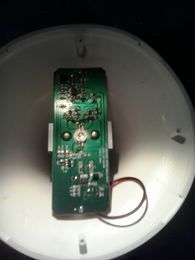GrundigRGBESP8266: Difference between revisions
Jump to navigation
Jump to search
No edit summary |
No edit summary |
||
| Line 40: | Line 40: | ||
* Lower voltage a bit (about 0.7V?) to power the ESP8266 | * Lower voltage a bit (about 0.7V?) to power the ESP8266 | ||
* Pray the pwm output has enough umpf | * Pray the pwm output has enough umpf | ||
== links == | |||
* https://www.conrad.nl/nl/grundig-rgb-mood-light-grundig-rgb-led-verlichting-mood-light-meerkleurig-1000346.html | |||
Revision as of 00:59, 4 February 2015
| Grundig RGB lamp with ESP8266 | |
|---|---|
| Participants | User:buzz |
| Skills | Electronics, Programming |
| Status | Planning |
| Niche | Electronics |
| Purpose | Infrastructure |
| Tool | No |
| Location | |
| Cost | |
| Tool category | |
Grundig_RBG_Mood_Light_PCB.jpg {{#if:No | [[Tool Owner::{{{ProjectParticipants}}} | }} {{#if:No | [[Tool Cost:: | }}
the plan
- Disable the shitty mcu inside the lamp (done)
- Solder wires to the vcc, gnd and pwm pins (nearly done)
- Connect a ESP8266 to it with nodemcu and some lua sauce
- ????
- Profit!
control mcu pinout
This is the unmarked IC labelled U1 on the silkscreen. , vcc is 4.24-4.3 volts
-------------
| o |
vcc ----| 1 5 |---- gnd
red pwm ----| 2 6 |---- blue pwm
? ----| 3 7 |---- green pwm
ir rx ----| 4 8 |---- ?
-------------
Funny bit is, the PWM signal is actually inverse. So they output a high signal to turn off the LED, and a low signal to turn on the LED. This can be proven by grounding one of the pwm output pins, which turns on the respective color of LED.
consideration
- Make wifi foolproof, webpage style config and 'robust'
- Do fancy fades inside the ESP8266 ?
- Lower voltage a bit (about 0.7V?) to power the ESP8266
- Pray the pwm output has enough umpf
